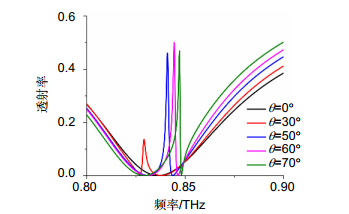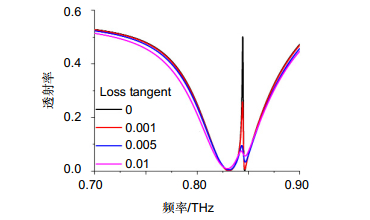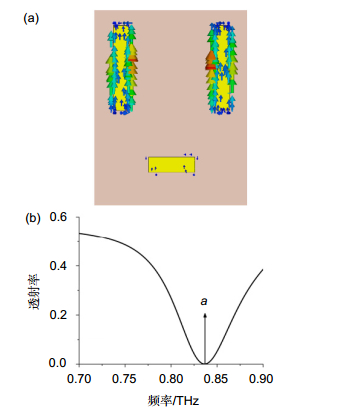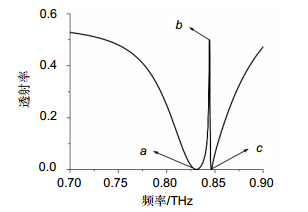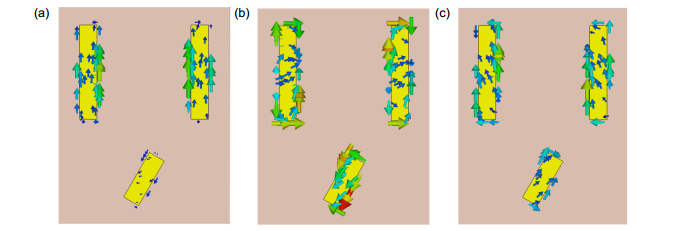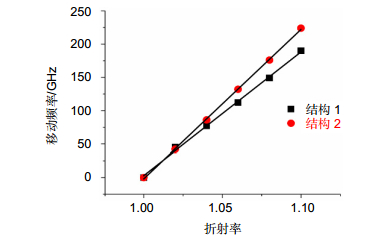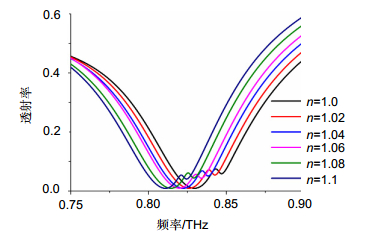-
摘要:
本文设计了一种具有电磁诱导透明(EIT)效应的太赫兹超材料,其单元结构由水平放置的单金属线以及垂直放置的双金属线组成。仿真结果表明,通过单金属线绕其自身中心旋转,可以激发出电磁诱导透明效应。金属线的旋转角度逐渐变大,透明峰的幅度也随之增大,当旋转角度为60°时达到最大值;旋转角度进一步增大,透明峰的幅度逐渐降低;旋转角度为90°时,透明峰消失。仿真说明该结构可以通过单金属线的旋转调控透明峰的出现。最后,对旋转角度为60°时结构的传感特性进行了分析。该结构设计简单,具有可调性、较高的Q值以及良好的传感特性。
 Abstract:
Abstract:A novel electromagnetically induced transparency (EIT)-like metamaterial of terahertz domain is proposed. The metamaterial is composed of a single metal wire and a couple metal wires above it. Numerical simulations demonstrate that by rotating the single metal wire around its center, EIT phenomenon is created. The amplitude of the transparent peak increases as the rotation angle increases. When the rotation angle is 60°, the amplitude of the transparent peak reaches its maximum. However, as the rotation angle keeps increasing, the amplitude of the transparent peak gets lower and the peak finally vanishes as the rotation angle equals 90°. We also analyze the sensing performance of the metamaterial with the rotation angle of 60°. The proposed structure is simple and adjustable, with high Q-factor value and good sensing performance.
-
Key words:
- terahertz /
- metamaterial /
- electromagnetically induced transparency /
- tunability /
- high Q factor /
- sensing performance
-

Abstract: A novel electromagnetically induced transparency (EIT)-like metamaterial in terahertz domain is proposed. The metamaterial is composed by a single metal wire and a couple metal wires above it. A plane wave propagates along the perpendicular direction to the structure with its electronic field direction paralleled to the double metal wires. The structure’s transmission spectra are simulated by CST Microwave Studio. In the simulation, the solver is chosen to be frequency domain solver while the boundary conditions are set as unit cell in x-y plane, and open (add space) in z-direction. The metal strips are set to be copper with its conductivity of 5.88×109 S/m and its thickness Δh=0.3 μm. The substrate material is quartz with its permittivity of 3.75 and thickness h=50 μm.
Numerical simulations demonstrate that by rotating the single metal wire around its center, EIT phenomenon is created. The single metal wire is regarded as quasi-bright mode element while the couple metal wires are considered as one bright mode element. The EIT phenomenon is produced by the interference between these two elements. The amplitude of the transparent peak grows as the rotation angle increases. When the rotation angle is 60°, the EIT window appears at 0.844 THz while the amplitude of the transparent peak exceeds 0.5 and reaches its maximum. It is remarkable that the width of the transparent window is only 1.57 GHz and the Q-factor is as high as 538, which makes the structure suitable for ultranarrow terahertz frequency selection. As the rotation angle keeps increasing, the amplitude of the transparent peak gets smaller and finally vanishes as the rotation angle equals 90°. Hence, we can tune the transparent window by rotating the single metal wire. The influence of the substrate’s dielectric loss is also simulated. The result indicates that the transparent peak is sensitive to the dielectric loss, and the amplitude of the transparent peak becomes quite small when the dielectric loss is 0.01. At last, we have analyzed the sensing performance of the metamaterial with the rotation angle of 60°. The structure’s refractive sensitivity is 228.9 GHz/RIU while its FOM value is 145.8. Therefore, the metamaterial can be used for refractive sensing. In conclusion, the proposed structure is simple and adjustable, with high Q-factor value and good sensing performance.
-

-
-
[1] Liu C, Dutton Z, Behroozi C H, et al. Observation of coherent optical information storage in an atomic medium using halted light pulses[J]. Nature, 2001, 409(6819): 490-493. doi: 10.1038/35054017
[2] Longdell J J, Fraval E, Sellars M J, et al. Stopped light with storage times greater than one second using electromagnetically induced transparency in a solid[J]. Physical Review Letters, 2005, 95(6): 063601. doi: 10.1103/PhysRevLett.95.063601
[3] Yannopapas V, Paspalakis E, Vitanov N V. Electromagnetically induced transparency and slow light in an array of metallic nanoparticles[J]. Physical Review B, 2009, 80(3):1132-1136. http://adsabs.harvard.edu/abs/2009PhRvB..80c5104Y
[4] Camacho R M, Broadbent C J, Ali-Khan I, et al. All-optical delay of images using slow light[J]. Physical Review Letters, 2007, 98(4): 043902. doi: 10.1103/PhysRevLett.98.043902
[5] Panahpour A, Latifi H. Electromagnetic transparency and slow light in an isotropic 3D optical metamaterial, due to Fano-like coupling of Mie resonances in excitonic nano-sphere inclusions[J]. Optics Communications, 2010, 284(6): 1701-1710. https://www.sciencedirect.com/science/article/pii/S0030401810013222
[6] Hau L V, Harris S E, Dutton Z, et al. Light speed reduction to 17 metres per second in an ultracold atomic gas[J]. Nature, 1999, 3(6720): 594-598. http://www.researchgate.net/publication/41224955_Light_Speed_Reduction_to_17_Metres_per_Second_in_an_Ultracold_Atomic_Gas
[7] Zhang Shuang, Genov D A, Wang Yuan, et al. Plasmon-induced transparency in metamaterials[J]. Physical Review Letters, 2008, 101(4): 047401. doi: 10.1103/PhysRevLett.101.047401
[8] Jin Xingri, Park J, Zheng Haiyu, et al. Highly-dispersive transparency at optical frequencies in planar metamaterials based on two-bright-mode coupling[J]. Optics Express, 2011, 19(22): 21652-21657. doi: 10.1364/OE.19.021652
[9] Guo Yinghui, Yan Lianshan, Pan Wei, et al. Electromagnetically induced transparency (EIT)-like transmission in side-coupled complementary split-ring resonators[J]. Optics Express, 2012, 20(22): 24348-24355. doi: 10.1364/OE.20.024348
[10] Han Zhanghua, Bozhevolnyi S I. Plasmon-induced transparency with detuned ultracompact Fabry-Perot resonators in integrated plasmonic devices[J]. Optics Express, 2011, 19(4): 3251-3257. doi: 10.1364/OE.19.003251
[11] Papasimakis N, Fu Y H, Fedotov V A, et al. Metamaterial with polarization and direction insensitive resonant transmission response mimicking electromagnetically induced transparency[J]. Applied Physics Letters, 2009, 94(21): 211902. doi: 10.1063/1.3138868
[12] Cao Wei, Singh R, Al-Naib I A, et al. Low-loss ultra-high-Q dark mode plasmonic Fano metamaterials[J]. Optics Letters, 2012, 37(16): 3366-3368. doi: 10.1364/OL.37.003366
[13] Tamayama Y, Yasui K, Nakanishi T, et al. Electromagnetically induced transparency like transmission in a metamaterial composed of cut-wire pairs with indirect coupling[J]. Physical Review B, 2014, 89(7): 075120. doi: 10.1103/PhysRevB.89.075120
[14] Qiao Shen, Zhang Yaxin, Zhao Yuncheng, et al. Mode coupling in terahertz metamaterials using sub-radiative and super-radiative resonators[J]. Journal of Applied Physics, 2015, 118(19): 193104. doi: 10.1063/1.4936169
[15] He Xun, Ma Qi, Jia Peng, et al. Dynamic manipulation of electromagnetically induced transparency with MEMS metamaterials[J]. Integrated Ferroelectrics, 2015, 161(1): 85-91. doi: 10.1080/10584587.2015.1036636
[16] Ma Yingfang, Li Zhongyang, Yang Yuanmu, et al. Plasmon- induced transparency in twisted Fano terahertz metamaterials[J]. Optical Materials Express, 2011, 1(3): 391-399. doi: 10.1364/OME.1.000391
[17] Shao Jian, Li Jiaqi, Li Jie, et al. Analogue of electromagnetically induced transparency by doubly degenerate modes in a U-shaped metamaterial[J]. Applied Physics Letters, 2013, 102(3): 034106. doi: 10.1063/1.4789432
[18] Cao Wei, Singh R, Zhang Caihong, et al. Plasmon-induced transparency in metamaterials: active near field coupling between bright superconducting and dark metallic mode resonators[J]. Applied Physics Letters, 2013, 103(10): 101106. doi: 10.1063/1.4819389
[19] Kurter C, Tassin P, Zhang Lei, et al. Classical analogue of electromagnetically induced transparency with a metal-supercon ductor hybrid metamaterial[J]. Physical Review Letters, 2011, 107(4): 043901. doi: 10.1103/PhysRevLett.107.043901
[20] Ding Jun, Arigong B, Ren Han, et al. Dynamically tunable Fano metamaterials through the coupling of graphene grating and square closed ring resonator[J]. Plasmonics, 2015, 10(6): 1833- 1839. doi: 10.1007/s11468-015-0003-6
[21] Yao Gang, Ling Furi, Yue Jin, et al. Dynamically tunable graphene Plasmon-induced transparency in the terahertz region[J]. Journal of Lightwave Technology, 2016, 34(16): 3937-3942. http://www.researchgate.net/publication/305037209_Dynamically_Tunable_Graphene_Plasmonically_Induced_Transparency_in_the_Terahertz_Region
[22] Sui Jiawei, Feng Ls. Optically and thermally controlled terahertz metamaterial via transition between direct and indirect electromagnetically induced transparency[J]. AIP Advances, 2014, 4(12): 127122. doi: 10.1063/1.4904227
[23] Yang Lei, Fan Fei, Chen Meng, et al. Active terahertz metamaterials based on liquid-crystal induced transparency and absorption[J]. Optics Communications, 2017, 382: 42-48. doi: 10.1016/j.optcom.2016.07.055
[24] Jin Xingri, Lu Yuehui, Park J, et al. Manipulation of electromagnetically-induced transparency in planar metamaterials based on phase coupling[J]. Journal of Applied Physics, 2012, 111(7): 073101. doi: 10.1063/1.3699197
-


 E-mail Alert
E-mail Alert RSS
RSS

 下载:
下载:
